Sign up for daily news updates from CleanTechnica on email. Or follow us on Google News!
Over the past few years I’ve published assessments of the hydrogen strategies of multiple jurisdictions, including the United States, Australia, Japan, Morocco, Algeria, Egypt, the EU, and the Canadian province of Ontario, among others. News of the German chancellor coming, cap in hand, begging for liquid natural gas and hydrogen from Canadian politicians as part of his energy crisis world tour a couple of years ago crossed my screen, and when asked I’ve given my opinion of the Maritimes’ hopes of a hydrogen export success story.
But I’ve avoided looking at Canada’s hydrogen strategy. And it has been avoidance. Canada is still wrapped around the axle by the legacy fossil energy industry. Canada’s government, especially since the Liberals took charge again in 2015, has diversified radically, dropping oil, coal, and gas percentages of GDP to only 0.9% combined as of 2020, with a brief upward blip due to the European energy crisis since. That’s down from 8.3% in the early 1980s, indicative of Canada’s growth of the non-fossil segments of its economy.
Despite that, all politicians still pander to the oil and gas industry, not just conservative ones. For no good reason, the Liberal government bought a pipeline with no future because its owners realized that there was no economic case for increasing its capacity. Subsequently, the crown corporation completed tripling its capacity for a vastly higher cost of CA$34 billion (US$25 billion) than originally budgeted and it’s entered operations as of this month. My projection, based on close scrutiny and analysis of energy and transportation trends globally, along with assessment of the quality of Alberta’s crude and the cost of refining it, is that the pipeline will likely never reach full capacity, will see diminishing capacity by 2035, and likely be bankrupt by 2040.
Canada committed with the rest of the G20 to eliminate fossil fuel subsidies in 2009. At the time, the Conservatives were in power and paid only lip service to the pledge. The Liberals started trying to unravel the subsidies when they took power in 2015, but foundered on the absurd tangled shoals of line items in dozens of ministries and agencies where fossil fuel lobbyists over the years had managed to slip in advantages for the industry.
Natural Resources Canada was better thought of until very recently as Fossil Fuels Canada With Some People Doing That Other Stuff. Subsidies for fossil fuels ballooned during the energy crisis at the time when the industry was seeing massive profits. During COVID, more billions were sent to the industry, earmarked for ‘cleanup’ of the left-behind mess that the industry wasn’t bothering to clean up itself.
Many parts of Canada have done an excellent job of reducing greenhouse gas emissions. Ontario was a leader globally in shutting down coal plants, pledging to do so in the early 2000s and completing the job in 2013, avoiding 37 million tons of CO2e annually. Quebec is a leading jurisdiction for electrification.
But gains elsewhere in the economy have been completely matched by increasing oil and gas emissions in Alberta especially, but also Saskatchewan. Methane emissions have also risen with increased fracking, burning of natural gas to power oil and gas facilities, and cold heavy oil processing with sand on the Alberta-Saskatchewan border.
Canada’s slowly increasing carbon price and rebate is studied globally as a leading and fiscally conservative, market-based approach to sweeping greenhouse gas emissions out of every corner of the economy. It’s working, so of course it’s being attacked by the Conservatives, where populist and simple-minded “Axe the tax” slogans with no pretense of a better approach to replace it are gaining ground.
Sadly, the way Canadian politics works is that the sensible, centrist Liberals retain power for 10-15 years, then Canadians get tired of them and we throw elections to the Conservatives for a while. This used to work well when the Conservatives were a credible and serious center-right party, interested in the welfare of all Canadians, aligned with empirical scientific reality and having tight control over their radical fringe. Sometimes even exceptionally well, as in the Brian Mulroney days that saw NAFTA, the Montreal Accord, and the acid rain treaty come into force. Those days are gone, and the Conservatives are a group of lightweights with little bench strength and policies written by some of the most conservative elements. Mulroney was likely the last credible conservative leader aligned with empirical reality, despite his flaws, and he tried to get the current crop to accept and lean into the reality of climate change before his passing.
It’s probable that the next election will see the Liberals out of power and the Conservatives in power, potentially with a majority. They’ll unravel virtually all of the good work on climate and potentially diversification of the economy while they are at it, beholden and aligned as they are to the fossil fuel industry in Alberta.
While I can look with relative dispassion and distance at the hydrogen foibles of the rest of the world, it’s difficult to maintain emotional objectivity for the subject in Canada. It’s depressing. Hence, the avoidance. But like those unpleasant but necessary visits to doctors, it’s time to face it.
The impetus for this was Michael Liebreich forwarding me Canada’s progress report on its 2020 hydrogen strategy. Yes, four years have passed since Canada published its own addition to the groaning bookshelf of misguided strategies on the Swiss Army molecule.
His pithy comment was “look at the resources it is absorbing! 31 action points, must involve many hundreds of people, and then it’s a few tens of millions here, a few tens there, it’s hundreds of millions of dollars being [commonly used and somewhat vulgar phrase indicating wasted effort]. Amazing!”
I’m certainly not going to argue.
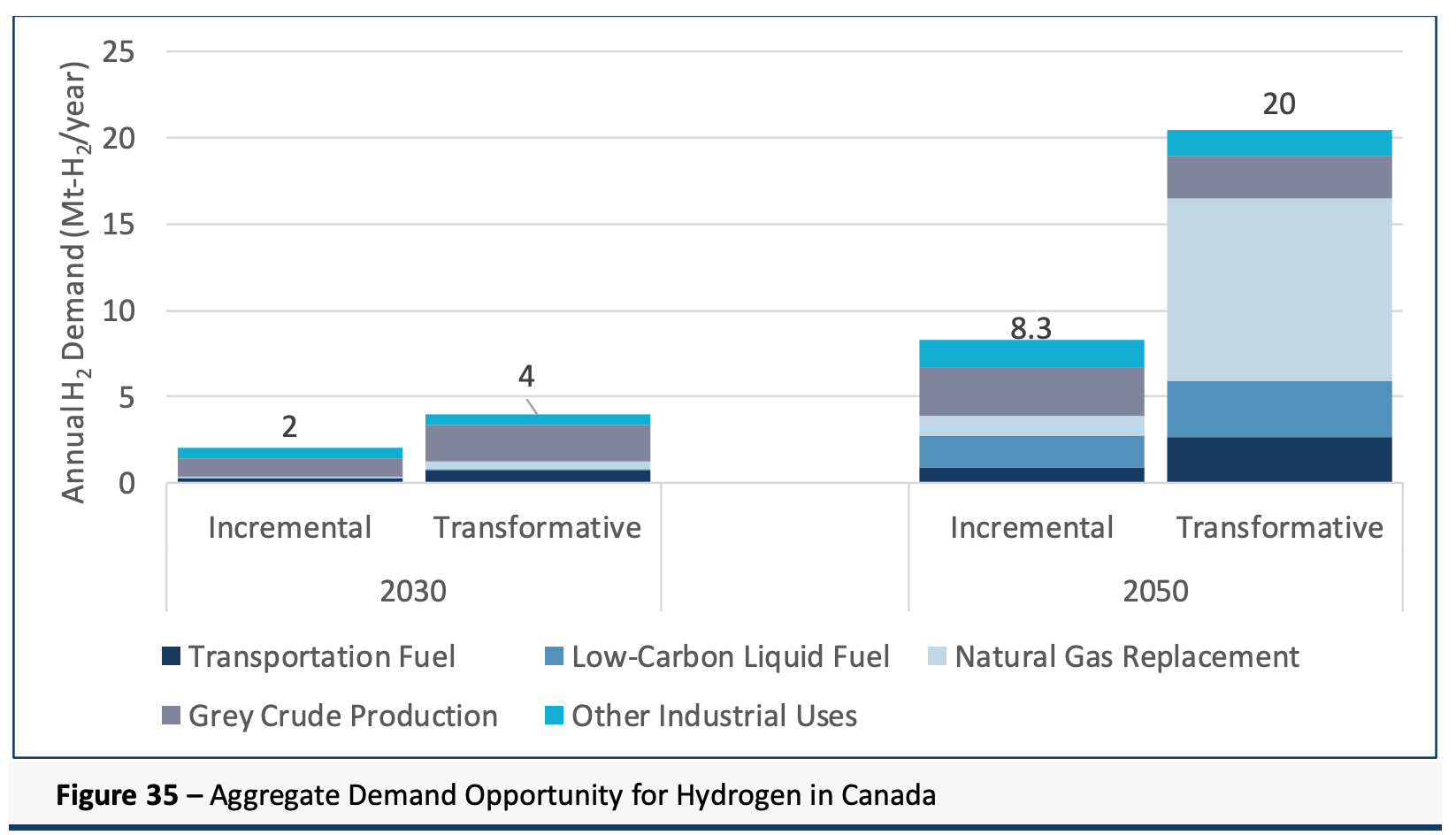
This chart from the 2020 document is fairly typical for this category of thing, and serves as a useful tool to make it clear that Canada had bitten deep into the hydrogen-for-energy apple and sent into a fairytale daydream. Currently Canada uses hydrogen to crack and cleanse its very heavy Alberta crude, manufacture ammonia-based fertilizers, and a handful of much lower volume end uses. Experiments with hydrogen for transportation have failed across Canada, with British Columbia, home to Ballard Power and many other hydrogen energy ecosystem firms, having a quiet policy of ignoring hydrogen for virtually all transportation after the disastrous Whistler Olympics bus trial.
Even in 2020, it was clear that battery-electric vehicles were going to dominate roads, and that rail electrification was a global solution that only North America was not actively progressing on. Despite that, the strategy’s vision for 2050 was 5 million fuel cell vehicles on Canada’s roads. That’s one in five vehicles having fuel cells, which was clearly not going to happen given global failures of hydrogen fuel cell trials, including in Canada, and the failure of hydrogen fuel cell vehicles to sell. Almost the last hydrogen fleet in Canada, Quebec’s 50 Mirais, were quietly returned to Toyota late last year without fanfare or analysis of the failure.
Only 11 months after the strategy came out, I published my projection of aviation demand and decarbonization through 2100, and not only was I projecting a strong opportunity for electrification, but felt it likely that sustainable aviation biofuels would dominate the sector. After all, they were already being bunkered and were clearly going to be less expensive, while e-fuels would be vastly more expensive, something I published on when I looked at direct air capture firm Carbon Engineering. NREL e-kerosene in the chart below is biokerosene, and the pathways to biofuels are vast, as are the biomass feedstocks available from waste streams.

It took a few months longer for me to get around to a complete workup and projection through 2100 of maritime shipping, but the same story played out there, with all inland and most short sea shipping simply electrifying, long-haul shipping diminishing rapidly as we won’t be shipping fossil fuels, and biofuels providing the energy required where batteries don’t suffice.
Also in 2022, Nature published a paper which did the cost and technical assessment to find that it wasn’t mass or volume of batteries which were limiters in maritime power, but capital cost. At a price of US$100 per kWh, 1,500 km routes were economically competitive with current bunker fuels without including any negative externalities. We’re already under $100 per kWh in the early months of 2024. At $50 per kWh, 3,000 km routes were competitive. Transportation battery giant CATL has announced that it will be shipping batteries for $56 per kWh in the fourth quarter of this year.
There is no place for hydrogen as a transportation fuel, and this was clear in December of 2020 when the strategy was published, at least for people who had done the cost workups. Similarly, e-fuels are a dead end, uncompetitive with batteries and grid ties on the ground and uncompetitive with biofuels for longer haul aviation and shipping. Anyone looking at the actual numbers and actual costs of how hydrogen and synthetic fuels were manufactured were seeing this clearly long before 2020. I’ve had conversations with global thought leaders like Dr. Joe Romm and Bruce McCabe, both of whom did the cost workups in the 2000s and realized the same thing.
This is more clear now, with the International Energy Agency’s e-fuels update of late last year making it clear that synthetic fuels would cost 4-6 times current fossil fuels, while biofuels would only be 2-3 times the cost.
To be clear, the Canadian hydrogen strategy’s low-carbon fuels category does include biofuels processed with hydrogen, something which is a growth area, but actual usage will be limited to aviation and maritime shipping.
The natural gas replacement category is purely delusional. A kilogram of hydrogen has 0.12 gigajoules of heat energy, so 8.3 kilograms are required for a gigajoule. The price point anyone realistic now imagines for green hydrogen in the future is US$5 per kilogram for manufacturing, and the reality is that current strike prices are averaging just over US$10. Picking out the low end of that, 8.3 kilograms would cost US$41.50 dollars, or CA$47.
What’s the current cost per gigajoule of natural gas in Canada? In BC, it’s CA$2.23. In Ontario, it’s just under CA$3. This is the price of heating for residential, commercial, industrial, and electrical generation heat being paid today, exclusive of distribution and administrative adders. The best case scenario is 16-21 times the cost of that. It makes the heating oil costs in eastern Canada pale by comparison. And natural gas is much less expensive to store and distribute than hydrogen, so connection and distribution costs will increase as well. The reality of green hydrogen delivered to homes and businesses would likely be 25 times the cost.
No one is going to pay this much for heat when there are alternatives, including heat pumps, induction stoves, electric arc furnaces, wind turbines, and solar panels. Green hydrogen is not remotely viable as a replacement for natural gas except as an industrial feedstock for things that absolutely require hydrogen, such as ammonia, and they are few and far between.
Blue hydrogen is cheaper than green hydrogen, along with having higher lifecycle greenhouse gas emissions, but only by about half in the best case scenario. That means 8-10 times the cost per gigajoule to make it, but still with the cost adders for storage and transportation. There is no world in which a country that makes the choice to power itself with hydrogen is economically competitive with sensible countries that avoid it and simply electrify with renewables.
The ten million tons of hydrogen to replace natural gas in the ‘transformative’ scenario in 2050 are specious nonsense, and they were specious nonsense in 2020.
You’ll note that gray crude production is the biggest consumer of hydrogen in both scenarios in 2030. That’s accurate, as Alberta’s crude is both very heavy and high in sulfur, the two characteristics which drive up demand for hydrogen in refineries. The assumption that Canada’s refineries are actually going to increase production of gasoline and diesel based on Alberta’s crude by 2050 flies completely in the face of climate action and economic reality. The world is pivoting away from burning petroleum products.
By 2050, the world will be well down the path of electrification of transportation and biofuels displacing fossil fuels globally. Canada’s hydrogen strategy assumes an increase in petroleum production.
The reality for Alberta’s crude is that it will be first off the market. It will be required to decarbonize its extraction, processing, and refinement further, which means burning dirt cheap natural gas to power steam-assisted gravity drainage, burning dirt cheap natural gas to power fossil fuel facilities and pipelines, and using gray hydrogen to refine Alberta’s crude will be off the table. The latter is the big kicker, as it requires about 7.7 kg of hydrogen to refine a single barrel of the stuff, per a workup I did mid-last year. Even at US$2.50 for blue hydrogen, that’s a US$19 quality discount against Brent crude by itself.
Green or blue hydrogen will increase the quality discount against competitive crudes globally while the market is awash in cheap, low-sulfur crude that’s close to water. The combination will mean that Alberta’s product won’t find buyers. Instead of Canada’s refineries being a growth market for hydrogen, they’ll be ramping down and shuttering.
You’ll note that other industrial uses barely move the needle on demand between 2030 and 2050. That’s the only actual market for hydrogen, as it includes both ammonia fertilizers and steel manufacturing, where hydrogen might be used as a reducing agent but definitely not as a source of heat.
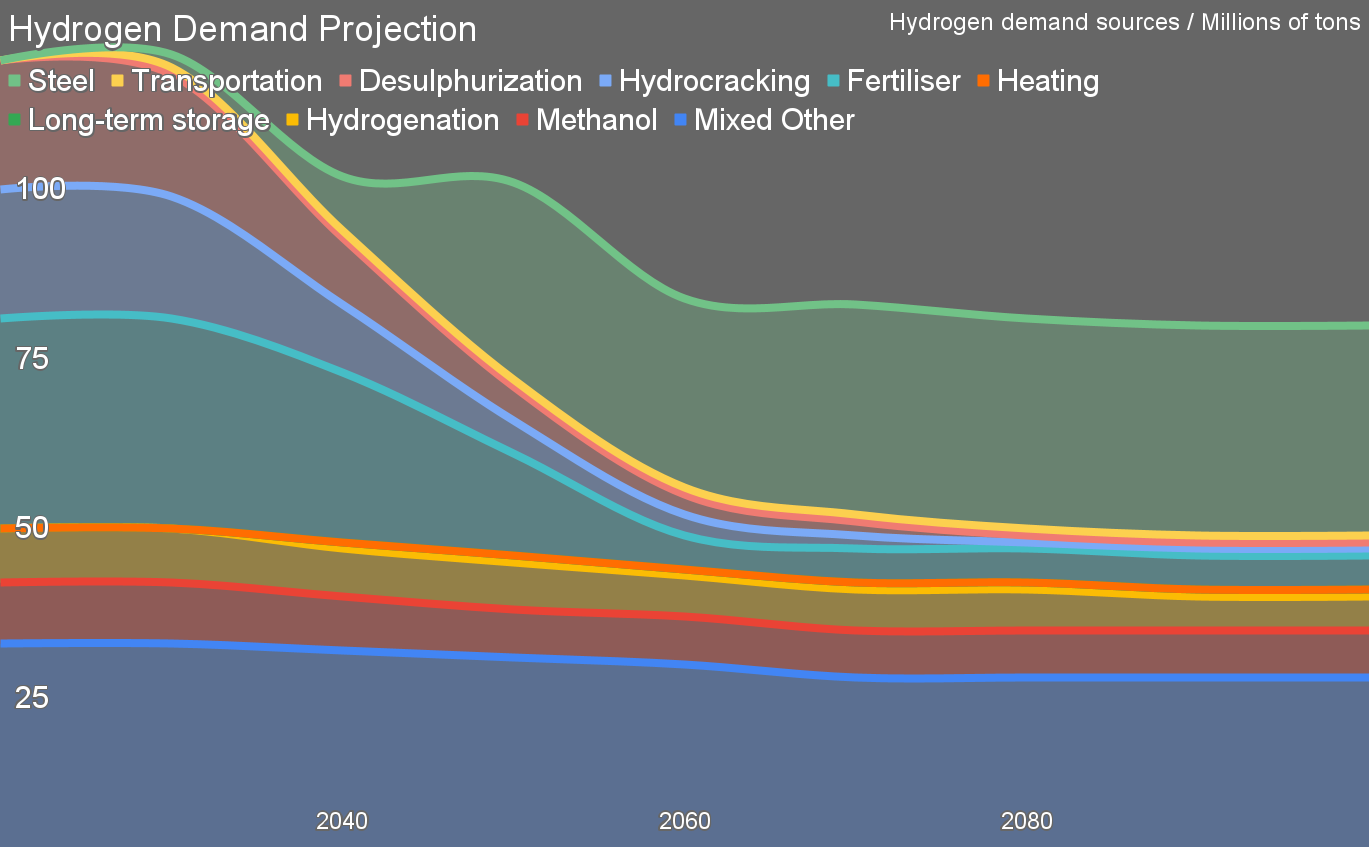
I developed my first projection of global hydrogen demand in late 2021, less than a year after Canada published its hydrogen strategy. The writing was on the wall already. Michael Liebreich’s hydrogen ladder was already in version 4.1 at that point and informing global discussions about the actual future for hydrogen.
The last time Liebreich and I discussed this, over dinner in London last year, his projection for end game hydrogen was higher than mine, but still much lower than the fantasies of a hydrogen economy. His hydrogen ladder includes coding to indicate where hydrogen has to compete with biological pathways, for example methanol, and direct electrification pathways. With every update, and it’s now at 5.0, more and more end use cases fall into the rung of doom, where there is zero economic viability.
These costs per gigajoule aren’t remotely hard to work up and are lifeblood analyses for most of the people involved in the hydrogen strategy. The costs of decarbonizing Alberta’s heavy, sour crude are readily available to the people who participated in the hydrogen strategy. Why didn’t they inform the strategy when so many of the participants can do the math?
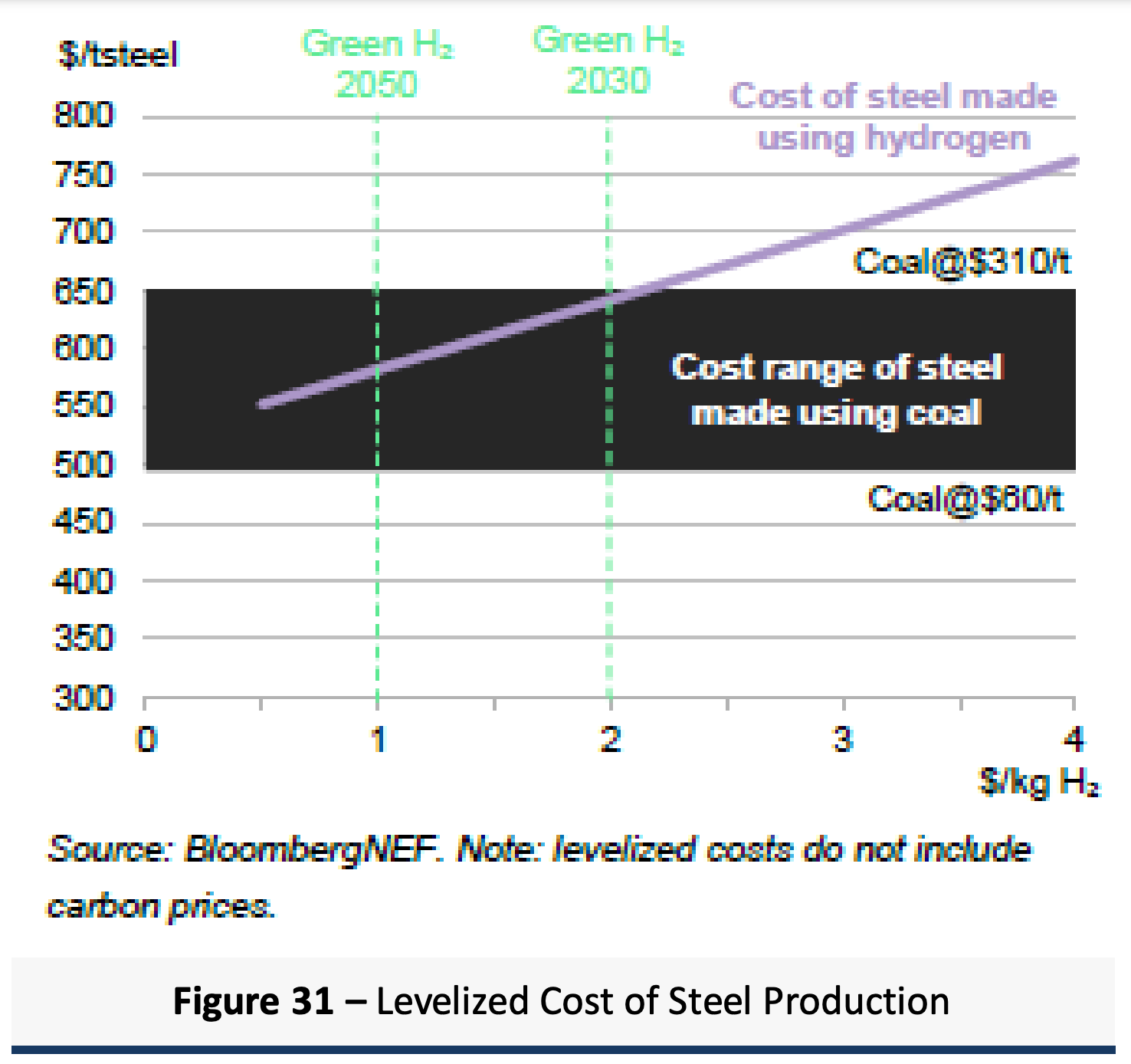
This chart on steel production from the strategy shows where Canada’s head was at in 2020. They were under the illusion that green hydrogen would be cheap, available at a cost to steel manufacturers of US$1-2 per kilogram. That’s well under the cost of manufacturing green hydrogen, and manufacturing costs exclude all of the costs of storage, transmission, and distribution of hydrogen.
Black and gray hydrogen today, where hydrogen pipelines exist as in Germany and Texas, costs US$6-8 per kilogram delivered. It costs over $10 when trucked. That’s the cheapest hydrogen that can exist, made from dirt cheap natural gas without any carbon capture.
Green and blue hydrogen will cost much more than that. Boston Consulting Group published a piece late in 2023 saying that the ‘consensus’ of €3 per kilogram green hydrogen by 2030 was no longer remotely realistic, and that €5-8 was the likely range. That’s the cost of manufacturing the hydrogen, not the cost of delivered hydrogen. As I said at the time, the consensus was among STEM- and economics-illiterate fantasists. The average strike price for green hydrogen manufacturing deals in 2023 was US$10.24 per kilogram.
The very high cost per gigajoule of hydrogen and the very present alternatives of heat pumps, heat pump hot water heaters, induction stoves, and the like means that there will be no hydrogen gas utility distribution network. The cost of hydrogen delivered would be based on custom built pipelines, not leveraging a massive customer base.
There is no world in which existing Canadian steel plants, clustered in southwestern Ontario, will get green hydrogen for US$1-2. That’s the only growth market for hydrogen. There are three firms I’m aware of, Boston Metals, Fortescue, and a third whose name escapes me, which are already demonstrating direct reduction of iron ore into iron using electricity and electrolysis processes without any hydrogen involved. I’m awaiting further results from that, but expect it’s likely to dominate that industry along with biomethane as a reducing agent in existing DRI syngas technologies from Midrex and ArcelorMittal. We’re already seeing European steel firms turning down massive subsidies to make green steel with hydrogen because the hydrogen costs far more than expected.
Canada’s Hydrogen Strategy Doesn’t Start From Reality
Regular readers will know where this is going, having read my (ignored) strategic guidance to Ontario, RMI, and others. Having worked professionally in strategy development and consulting for about 25 years, among other things I’ve read virtually every book on the subject. The only one I recommend for business and policy discussions — not military discussions — is Richard Rumelt’s Good Strategy Bad Strategy.
Rumelt defines the kernel of a good strategy has having three elements. First is that a bleak, pragmatic, and clear-eyed perspective of reality must be the basis. After that, policies on what avenues an organization or country will explore for advantage and to avoid risks must be created. Then action plans must be in place.
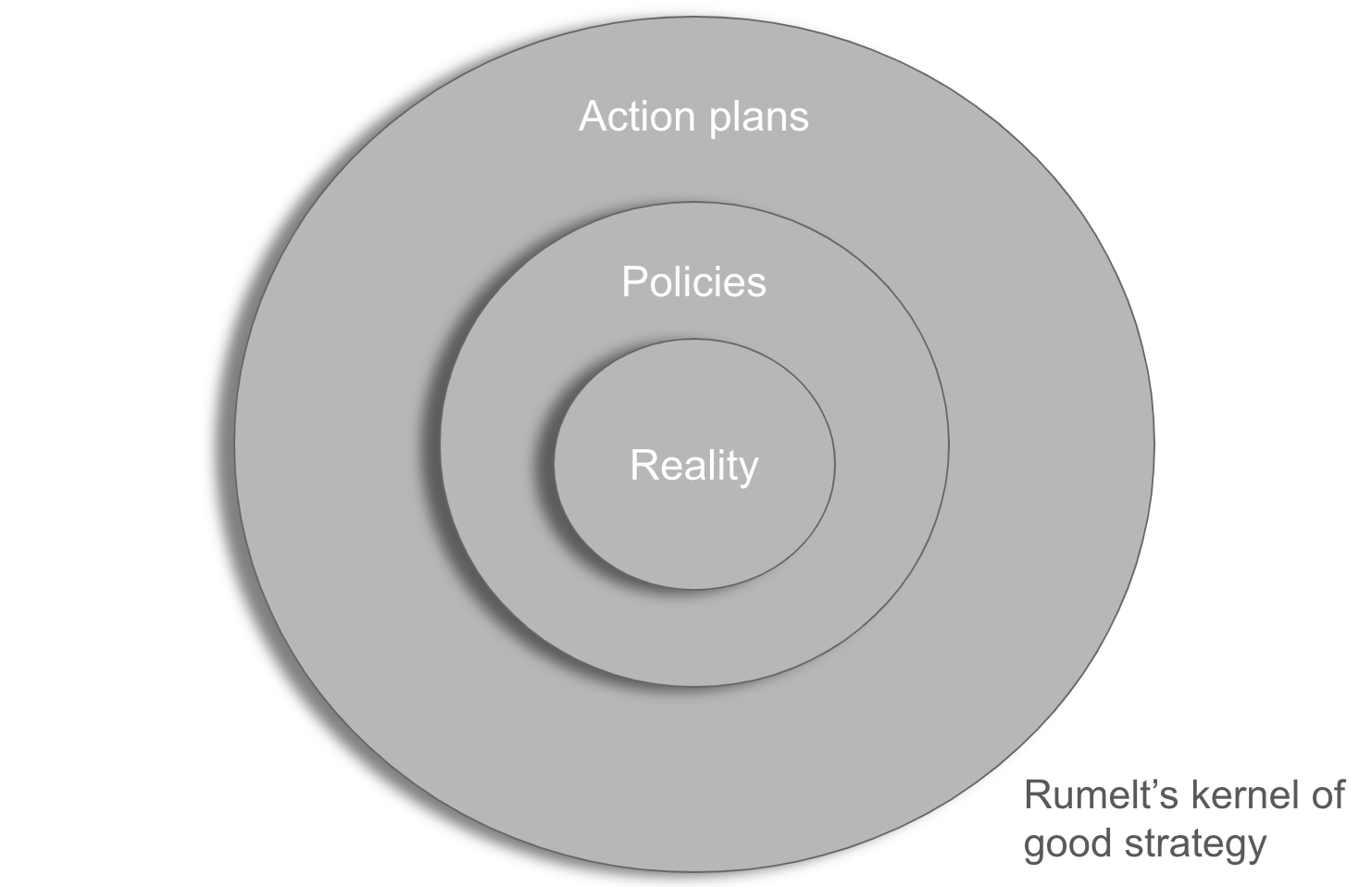
If you get reality wrong, everything else falls apart, and that’s what Canada’s hydrogen strategy has done. Like Australia’s net zero plan which fantasizes about a global hydrogen export industry that will enable them to export even more energy than they already do — the country exports four times as much fossil fuel energy as their entire economy consumes — Canada’s strategy starts with a false assumption that hydrogen is a major player in energy and as such falls over badly.
As a result, Canada’s progress has been mostly non-existent. Seven limited truck and bus trials underway. Four train trials claimed, but one was a three-month tourist train trial in Quebec last year, and they must be counting CPKC’s — the amalgamation of Canadian Pacific and a US railroad firm — trials across North American to get up to four trials.
5,700 households served by tiny percentages of gray hydrogen blended with natural gas, something which increases the cost of the gas and diminishes the energy it can provide. There are 15.3 million households in Canada, so this homeopathic trial is less than the concentration of carbon dioxide in the atmosphere and vastly less significant. It’s a faint hope gasp by the gas utilities to delay the inevitable utility death spiral that they should be actively working on by strategically downsizing their networks, sub-isolation network by sub-isolation network, as actually clear-eyed gas utilities like Utrecht’s are doing.
Eight operating hydrogen refueling stations, which is up one from 2020, although the one in Quebec City’s suburbs is gathering dust after the governmental fleet was abandoned.
There’s a claim of $527 million in revenues for hydrogen sector companies, which is remarkable as Ballard has lost an average of $55 million annually since 2000. Most hydrogen revenues come via big grants from governments for hydrogen bus and truck trials which are abandoned as soon as the governmental taps close.
Apparently almost 4,300 people are employed full time in the industry, about 0.2% of Canada’s workforce. I assume that includes a lot of governmental staffers working on dead end policies, agreements and standards. While I’m not a small government ideologue by anyone’s standard, this is a place the government could save some money. It includes a bunch of fossil fuel industry types trying vainly to pretend that the absurd costs per gigajoule of hydrogen will actually be paid by anyone. If the latter weren’t getting massive subsidies and governmental grants, I wouldn’t be particularly incensed about it, but most of this debacle is being funded by tax dollars, including the ones that I pay.
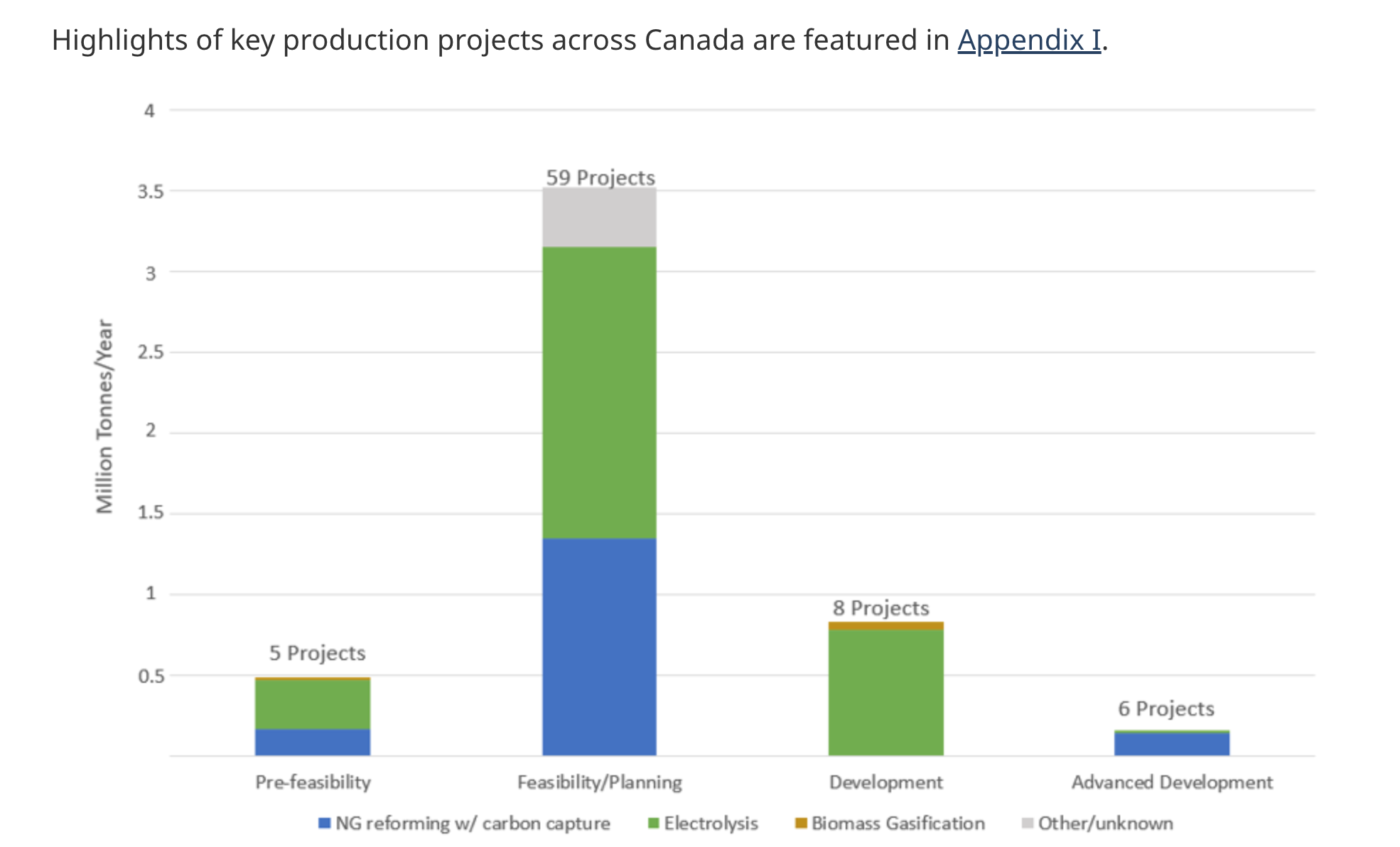
Of the 78 projects, only 6 are currently in construction and they are virtually all blue hydrogen from natural gas. The vast majority have not reached final investment decision, and once again the global statistics on hydrogen manufacturing projects make it clear that they are unlikely to. Boston Consulting Group reported late last year on the 1,300 proposed green hydrogen projects in their data set, and only 0.2% by tonnage had reached operation with the vast majority coming nowhere near final investment decision. Bloomberg New Energy Finance reported that of the 140 projects in their data set, only 10% had any form of off take agreement, most of them not firm.
This will be the reality for Canada’s proposed hydrogen projects as well. Most of them are based on false assumptions about the market and the costs of manufacturing and transporting hydrogen, and as spreadsheet jockeys who are required to validate numbers and use realistic ones in cost workups do their work, most of these will quietly disappear.
Naturally, of the six that under construction, a big one in Edmonton is manufacturing blue hydrogen using autothermal reforming — heating natural gas in the absence of oxygen in a pressurized container to manufacture four tons of carbon for every ton of hydrogen — and still letting a minimum of 10% of the greenhouse gases escape, probably not counting methane leakage. They are planning to use that for the non-existent transportation and electrical generation markets for hydrogen, so that’s not going to end well. I assume that they are hoping that Edmonton’s crude oil refineries will take it, but Shell has already received billions for its own blue hydrogen facility for that purpose and as noted, demand will plummet. Nonetheless, CA$475 million in funding for this blue hydrogen failure in the making. It’s completely unsurprising to me that the biggest projects that have actually reached construction are from fossil fuels.
Naturally HTEC in Burnaby got almost $25 million of governmental largesse and is building a small green hydrogen plant to put hydrogen into the tiny refueling network in the province. All to power the handful of Toyota Mirais left in the province, including UBC’s fleet which is often parked at the HTEC station on Granville waiting for the pump to work, for hydrogen to be available at all, or for other drivers to finish the slow refueling process. Some of the money is earmarked to buy a handful of hydrogen trucks which they hope to rent out for drayage and the like, but the odds of the trucks sitting gathering dust is high.
A renewable diesel facility in Prince George just completed construction, beating the Teralta waste hydrogen deal it seems. No statement of how much money it received in the progress report, but press releases indicate at least $43 million of the $380 million cost was funded by the government. At least this facility will be able to provide fuel for long-haul maritime shipping, so it’s not a waste of time and money. It is interesting that the biodiesel facility didn’t take the hydrogen from the chloralkali plant. The facility will be manufacturing about 400 tons of renewable diesel a day from various oils and needs about 38 kilograms per ton of product. That implies about 15 tons of hydrogen, and the chloralkali plant had 12 tons a day begging for a taker. Instead, that 12 tons will be burned to displace a quarter of the natural gas burned in a local paper mill, something that could simply electrify, and should have.
While they are claiming six projects are under construction, these are the only three that the document has any reference to being in construction, with a few others in operation.
Naturally, many of the claimed benefits are places where carbon capture is being applied to existing production — yet another subsidy to the fossil fuel industry. Between the overwhelming natural gas reformation in the projects under construction and the existence of carbon capture, this is clearly a situation where the federal government is giving more money to the wrong industry again.
There is $17.7 billion in investment tax credits up for grabs, $1.5 billion in the Clean Fuels Fund, $315 million from the Net Zero Accelerator so far, $15 billion in the Canada Growth Fund which has a hydrogen priority, almost $900 million from the Canada infrastructure Bank so far, $680 million in the Zero Emissions Vehicle Infrastructure Program which is committed to wasting a bunch of it on 30 hydrogen refueling stations, $2.7 billion in the Zero Emission Transit Fund which pays a premium for transit operators to waste time on hydrogen, $550 million in the Incentives for Medium and Heavy-Duty Zero-Emission Vehicles which will happily pay trucking firms to buy hydrogen trucks, another $75 million in the Zero-Emission Trucking Program which once again will happily throw money at hydrogen trucks, and a cool billion in the Green Municipal Fund which will provide grants to cities and towns that are too foolish to avoid hydrogen like the economic plague it is. After four years, there’s virtually nothing but fossil fuel projects to show for it.
Approaching $25 billion of governmental money is available to be mostly wasted on hydrogen projects. Many of those funds will support sensible electrification, but a lot of it is just a dead end. Much of the funding will, of course, flow to the fossil fuel industry for blue hydrogen. Their lobbyists and grant writers are among the best in Canada.
Of course, to put this in context, the government did spend $34 billion on a fossil fuel pipeline to nowhere. The hydrogen folly could be worse.
Have a tip for CleanTechnica? Want to advertise? Want to suggest a guest for our CleanTech Talk podcast? Contact us here.
Latest CleanTechnica.TV Video
CleanTechnica uses affiliate links. See our policy here.





